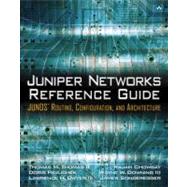This book is designed to be an introduction to the Juniper Networks family of Internet routers and the Juniper Networks Operating System (JUNOS). During the past several years, Juniper Networks has grown immensely and captured a large share of the Internet-router market, replacing Cisco in advanced routing solutions. Independent organizations using industry-recognized test standards have identified Juniper Networks as the leader in Internet and carrier-class core routing solutions. They have taken this lead and developed an extremely effective router architecture and command-line interface (CLI) to become the single largest threat to the dominance of Cisco Systems.
There is no doubt that the bookshelves are seeing more and more space dedicated to the Juniper Networks product line. This book stands apart from the others because of its range and depth: It covers the basics of Juniper Networks' product line, provides concise explanations of internetworking theory, and contains detailed examples that will enable a network engineer to configure the products. The chapters contained herein walk readers through how Juniper Networks was formed and the industry need that its foundation answered. A little background is good, but most network engineers want the technical details of the topic. This book delves immediately into the architecture of a Juniper Networks router and the intricacies of JUNOS. If you are new to JUNOS, these chapters cover all you need to know, from logging into the router to ensuring you have enough knowledge to pass the Juniper Networks Certified Internet Specialist (JNCIS) examination. If you are experienced, then the tested configuration examples provided throughout the book will challenge you and provide vital references for application in your network.
Juniper Networks is rapidly becoming the leader in shaping technology that affects the Internet. This book focuses on the Internet building-block technologies, such as Border Gateway Protocol (BGP), and policies; however, we also look to the future with in-depth coverage of multiprotocol label switching (MPLS) and virtual private networks (VPNs). In addition, this book contains a high level of information about the entire range of products and the technologies behind them. This powerful approach gives you a deeper understanding of the business drives and corporate culture that other books will not provide.
Intended Audience
This book is written for those who desire to learn more about JUNOS and Juniper Networks routers. It does not matter if you are new to Juniper Networks routers or preparing to become a Juniper Networks Certified Internet Expert (JNCIE)--this book has something for everyone.
- People involved in networking and interested in learning how to design and deploy Juniper-based network solutions
- Individuals who need to deploy or maintain multivendor routing solutions
- Networking professionals interested in learning what the primary competitor of Cisco is doing and how its networks are designed
- Cisco-certified engineers who want to remain current in a changing market
This book will serve as an excellent tool for building the necessary knowledge level required to operate and configure Juniper Networks routers, as well as to aid in preparing for the Juniper Networks Certification Exams.
Organization of This Book
This book is divided into four parts. Part I, "Juniper Networks: An Overview," introduces readers to the strong entry of Juniper Networks into carrier-class routing and discusses the company's efforts in education and certification with a brief review of core technologies. Part II, "System Configuration," covers all the steps needed to install a Juniper Networks router and make it function to include network management and security.
Part III, "Interface and Routing Protocol Configuration," covers internal routing protocols, such as Open Shortest Path First (OSPF) and Intermediate System to Intermediate System (IS-IS), and provides an extensive discussion of external gateway protocols, such as BGP. Part IV, "Advanced Router Operation and Configuration," covers routing policies, along with MPLS, VPNs, and Multicast.
How to Use This Book
Many chapters end with case studies. These case studies are taken from real-world router configurations and range from examples of implementing solutions using Juniper Networks routers to templates that can be easily applied to your network or used to guide you in preparation for the JNCIE.
Each chapter has a bibliography that lists additional texts, Web sites, and the appropriate standards relevant to each chapter. The chapters reference many Requests for Comments (RFCs). The Internet Engineering Task Force (IETF) is the body responsible for producing standards for Internet Protocol (IP) and routing protocols used for IP networks. The IETF drafts the RFCs that can then be implemented as the standard for that protocol or IP service. To access RFCs and drafts, go to the IETF Web site at www.ietf.org. These standards are current at the time of this writing and are located online at www.rfc-editor.org/rfc.html. It is our hope that you can use this book as a reference for your network today and in the future. Good luck.
Thomas M. Thomas IIDoris Pavlichek
Lawrence H. Dwyer III
Rajah Chowbay
Wayne W. Downing III
James Sonderegger
0201775921P11042002








